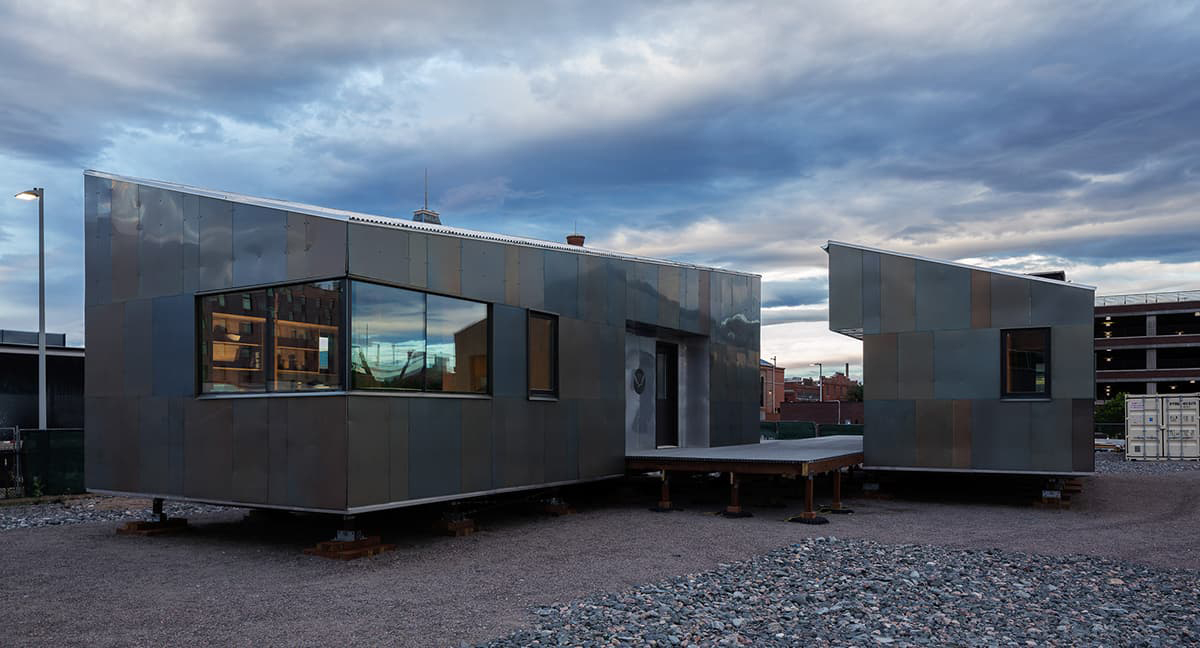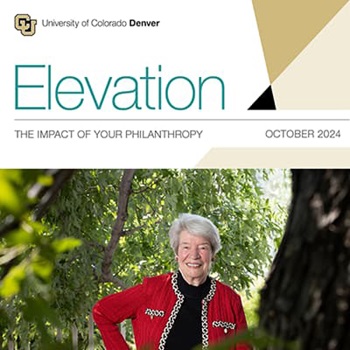Building a Place for Purpose
Dec 12, 2022
Johnson, a successful architect with a career spanning multiple decades, is CU Denver’s largest-ever donor, having given millions to the university and its College of Architecture and Planning (CAP) through the Dr. C. W. Bixler Family Foundation and personal contributions.
Johnson has not only transformed CU Denver through his contributions. His vision has led to some of the university’s most important leaps forward.
Seeing the opportunity for experiential learning and applying design principles to real-world problems, Johnson helped create the Colorado Building Workshop, CAP’s award-winning design-build certificate program for students pursuing a master’s degree in architecture.
The Colorado Building Workshop fulfills what Johnson sees as the promise of architecture. The design-build program centers on the practical application of architectural theory and promotes a blend of hands-on skills, creative design, and cutting-edge materials to construct buildings for communities in need.
“It’s hands-on, experiential learning,” Johnson says.
Sometimes, the problems that the design-build program solves are close to home. Others, they’re 10,000 miles away.
 In Spring 2022, the workshop took on the challenge of building a field camp in Antarctica for the National Oceanic Atmospheric Administration’s National Marine Fisheries Service.
In Spring 2022, the workshop took on the challenge of building a field camp in Antarctica for the National Oceanic Atmospheric Administration’s National Marine Fisheries Service. The camp, named Cape Shirreff, provided safe, sustainable shelter for eight NOAA scientists conducting marine ecosystem research in some of the harshest conditions on earth.
Twenty-eight students engineered, designed, and built a new dormitory, kitchen, and living room for the scientists. In August, the buildings, which feature privacy, natural lighting, and low-maintenance metal cladding, were taken apart, packed into shipping containers, and sent on a 7,000-mile trip to Antarctica.
In 2023, the Colorado Building Workshop plans to begin Phase II of the project, which includes designing and building an eco-friendly lab and small animal observation facility for the camp. The Bixler Foundation is funding professional filmmakers to produce a documentary of the Cape Shirreff project.
Rick Sommerfeld, assistant professor and director of the Colorado Building Workshop, attributes much of the program’s success to Johnson, who not only provides financial support but encourages Sommerfeld to constantly redefine what’s possible for the program.
“There are probably two or three programs across the country working on projects with these timelines, constraints, and consistency,” says Sommerfeld. “A big part of that is Don’s support.”

Johnson’s Vision Shaped By Experience as an Architect and an Entrepreneur
After graduating from CU Boulder in 1962 with a degree in interior architecture, Johnson moved to Los Angeles where he worked for two other design firms before he founded Aegina Associates, which grew into an influential firm in the city. For Johnson, the Rocky Mountains beckoned. He returned to Colorado, where he designed Erie Village, which has become a prized real estate development in Boulder County.Currently, Johnson serves as Managing Trustee of the Dr. C.W. Bixler Family Foundation, which is named after his grandfather, Clarence Ward Bixler, a 1907 graduate of CU’s School of Medicine. The foundation supports CAP in several ways, including the Bixler Global Initiatives, which promotes learning through international experiences, and Colorado Building Workshop. Johnson’s funding also supports scholarships, safety equipment and tools.
The foundation contributes to causes in Colorado including other University of Colorado campuses. But it’s CU Denver and CAP that have captured Johnson’s heart.
“CU Denver serves the people of our community for whom higher education can make the biggest difference,” Johnson says. He proudly points to the fact that half of the university’s undergraduates are students of color, and half are first-generation college students.
Johnson is also enamored with the university’s location in downtown Denver, which he believes has what it takes to draw the brightest minds in any field. “CU Denver is right there, in the midst of it. It’s the city’s university.”
Dreams Actualized and Making Impact
For Johnson, who first dreamed of being an architect at age five, the field represents more than just a path to a successful career. It’s a creative outlet that redefines what it means to bring your work to life.“You picture something in your mind for so long,” Johnson says, recalling his planning and design of neighborhoods that include 350 homes. “Then, when you walk out there one day and you see it. There’s nothing like it.”

Johnson has also come to see architecture as a way to make an impact on people’s lives.
“When you realize that you’ve impacted thousands of people, not just during their lifetimes but for generations to come, it’s incredibly fulfilling,” he says.
While the personal impact of architecture is undeniable, Johnson also sees it as a path to solve problems at scale. “We need more affordable housing,” he says. “We have the potential to do so much more, and architects are going to be essential to getting it done.”
Johnson’s support of CAP’s design-build program is fueled by this passion for experiential learning in pursuit of social good. It’s a passion shared by the program’s students.
Johnson recalls a recent project in the mountains, which saw students re-design and construct new backcountry privies on Longs Peak, the tallest and most iconic mountain in Rocky Mountain National Park.
“Students were out there working at 11,500 feet and camped at 9,000 feet building these structures,” Johnson says. “But they knew why they were doing it. Their enthusiasm was electric.”
Johnson’s Entrepreneurial Mindset Shines Through His Approach to Philanthropy
“I don’t make contributions or donations,” he says. “I invest, and I expect to see results.”Key to achieving those results: talented, dedicated faculty who go beyond what they’re counted on to deliver. In Rick Sommerfeld, the Colorado Building Workshop’s director, Johnson has a leader he can trust to deliver the maximum return on his investment.
“He’s a tremendous leader,” Johnson says of Sommerfeld. “He sleeps in the tents with students, preparing food. When they’re working in the field, he is there, tools in hand, working alongside them. The students have so much respect for him.”
Johnson does his best to mirror Sommerfeld’s hands-on approach. “Don’s always asking, ‘What do you need? What’s on your wishlist? How can I help?’” says Sommerfeld.
Now, Johnson plans to take CAP to even greater heights with funding that aims to recruit the best faculty, support students through scholarships, and provide the best possible education.
The foundation for what Johnson refers to as “CAP 2.0” is already being laid.
Johnson is working with CAP leaders, including Dean Nan Ellin, to create a design-build program at the undergraduate level. The result is the Bixler BioDesign Studio, which will teach students about the practical application of architectural theory by designing and constructing unique and functional structures and buildings.
“We're integrating more biological processes and pushing the research forward,” Johnson says. “No architecture firm can do that.”
This interdisciplinary approach represents the future of architecture. “The whole field of architecture is expanding. There’s no end to how we can integrate with other disciplines to make the world work better,” Johnson says.
Johnson hopes that his ongoing support of CAP will draw attention to CU Denver as a whole. “I can’t wait for the day when people across Colorado wake up and pay attention to what a gem this university is, not just for our state but for our country.”
Main story image, courtesy of Rob Cleary, www.rvcleary.com.



